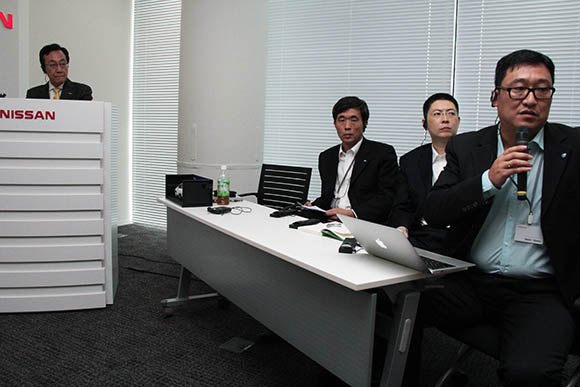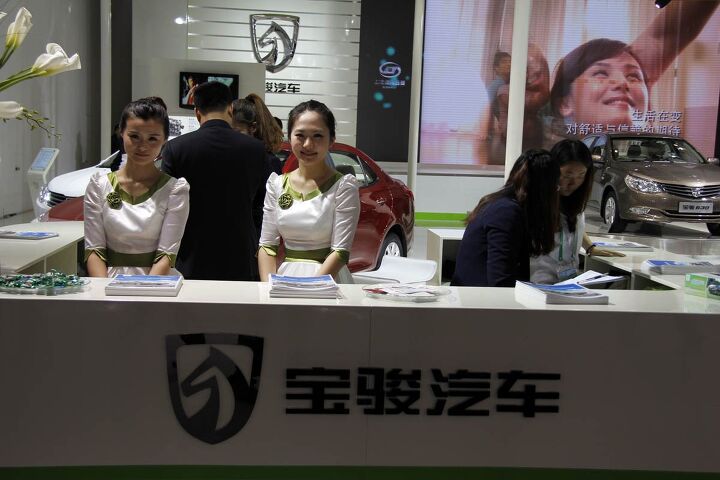Why Foreigners Create Chinese Brands, Explained Using Nissan And Venucia

Dongfeng-Nissan President Kimiyasu Nakamura watches Yao Bin, Huang Kai Fong, and Ye Lei
Yesterday, Nissan’s affable China president Kimiyasu Nakamura brought a Chinese delegation home to Yokohama, to explain to a largely skeptical Japanese press why Nissan had started a new brand in China with joint venture partner Dongfeng. The brand goes by the name of Venucia. Nissan is not the only one doing that. Nearly every foreign joint venture partner in China either has established a Chinese brand in China, or is intensively thinking about it.
Curiously, the trend of foreign joint ventures making Chinese cars had been started by GM, which announced its Baojun brand in 2010. This was quickly followed by Nissan and Venucia. Pretty soon, it became known that these branding exercises had not been totally voluntary. The Chinese government strongly suggested to all joint ventures that it would be a great idea to launch an independent Chinese brand that is owned by the joint venture. There is no law that requires this, but foreigners quickly realize that is is in their best interest to play along.
When it comes to new energy cars that are supposed to benefit from Chinese subsidies, then the car absolutely must be built and sold under a Chinese brand, Nissan’s CEO Carlos Ghosn said at this year’s Beijing Auto Show. Nissan’s Leaf will be a Venucia when it comes to China.
Except for the cut and dry subsidy issue, the overarching reason for these pseudo Chinese brands is not completely clear.
Officially, it is supposed to make the car more affordable. Lower cost cars definitely are the key to China’s expanding market, as cars morph from toys for the rich to transport for the masses. However, foreign makers privately had long argued that one does not need a new brand to make an affordable car, as the Jetta and Santana vividly illustrate in China. Actually, to seriously launch a new brand can be quite costly.
Conspiracy buffs argued that the insidious Chinese are trying to grab valuable IP with that scheme. Foreign joint venture partners snicker at that idea. The cars they introduce under the Chinese brands typically are based on previous-gen platforms. And electric cars? “How much protectable IP is in the concept of rigging electric motor to a battery?” the R&D chief of a Japanese carmaker had quipped last year.
Sales and market share passenger vehicles in China by brand nationality, January-April 2012
CountryUnitsShareJapan948,00018.8%Germany868,30017.2%USA553,90011.0%Korea399,8007.9%France142,1002.8%Total foreign2,912,10057.7%Chinese2,137,00042.3%Total5,049,100(Source: CAAM.)More and more, it appears as if it is a grand whitewashing exercise. The market share of indigenous brands is anywhere between 30 and 40 percent, depending on who you ask and how the counting is performed. All agree that the market share of indigenous brands is sinking. “Despite a massive local presence, the domestic car industry is steadily losing market share,” wrote state-owned Xinhua in April.
It pains the patriotic pride when that happens. On the other hand, Chinese partners of joint ventures with foreign carmakers are nearly all state owned enterprises, whereas domestic brands are often in the hands of small and medium sized independents. The government would shoot itself in both feet would it favor the independents.
New “Chinese” brands.Developing table
FordInstead, a Chinese solution was found. The strong joint ventures create Chinese brands that hopefully make the domestic brand statistics look better as time goes on, and at the same time, both laowei and Chinese SOEs keep their lines busy. The foreigners can recycle old platforms and tools that otherwise would have been scrapped. The Chinese can be proud that they don’t have to pay license fees for a brand, something that goes against the grain of a Chinese anyway. The foreigners more or less happily play along.
Nissan said yesterday that it sold 7,700 Venucia D50 in the first month after its 4/23/2012 launch, which is “a good start,” as Chris Keeffe of Nissan put it. Venucia outsold the Baojun which had 5,013 units in May. Dongfeng Nissan wants to launch another Venucia car in 2012, for a total of 5 by 2015.

Bertel Schmitt comes back to journalism after taking a 35 year break in advertising and marketing. He ran and owned advertising agencies in Duesseldorf, Germany, and New York City. Volkswagen A.G. was Bertel's most important corporate account. Schmitt's advertising and marketing career touched many corners of the industry with a special focus on automotive products and services. Since 2004, he lives in Japan and China with his wife <a href="http://www.tomokoandbertel.com"> Tomoko </a>. Bertel Schmitt is a founding board member of the <a href="http://www.offshoresuperseries.com"> Offshore Super Series </a>, an American offshore powerboat racing organization. He is co-owner of the racing team Typhoon.
More by Bertel Schmitt
Latest Car Reviews
Read moreLatest Product Reviews
Read moreRecent Comments
- Jrhurren Worked in Detroit 18 years, live 20 minutes away. Ren Cen is a gem, but a very terrible design inside. I’m surprised GM stuck it out as long as they did there.
- Carson D I thought that this was going to be a comparison of BFGoodrich's different truck tires.
- Tassos Jong-iL North Korea is saving pokemon cards and amibos to buy GM in 10 years, we hope.
- Formula m Same as Ford, withholding billions in development because they want to rearrange the furniture.
- EV-Guy I would care more about the Detroit downtown core. Who else would possibly be able to occupy this space? GM bought this complex - correct? If they can't fill it, how do they find tenants that can? Is the plan to just tear it down and sell to developers?






































Comments
Join the conversation
I finally read "American Wheels, Chinese Roads," which was reviewed by Ed here: http://online.wsj.com/article/SB10001424053111904006104576501302843644740.html The author focuses on "how business must be done in China." Building relationships with the government at the local and national levels is key. We hear very little about the challenges involved in actually manufacturing and marketing the cars--apparently these activities are secondary. The main thing I had not realized: city governments are major players, and these do not remotely form a unified block with the national government. The Chinese partner in all of these JVs is actually a city government, Shanghai for GM and VW, Dongfeng for Nissan, and so on. In the long-term the Chinese plan to have these JVs function as independent companies that will eventually export their cars and directly compete with the Western partner. While in the short-term forcing the JVs to create a Chinese brand serves as whitewashing, it also fits this long-term strategy. The book's author recommends that the US reciprocate by making Chinese companies follow the same rules in the US. But of course this will never happen.